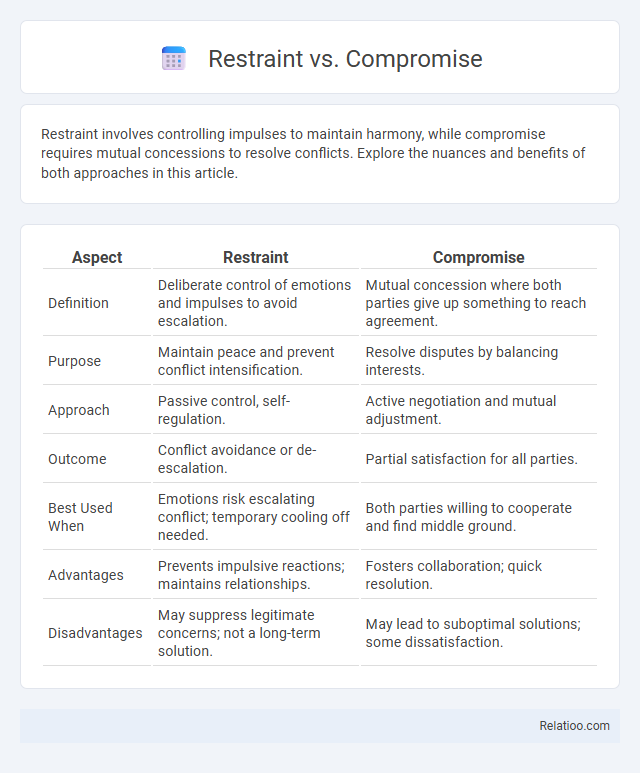Restraint involves controlling impulses to maintain harmony, while compromise requires mutual concessions to resolve conflicts. Explore the nuances and benefits of both approaches in this article.
Table of Comparison
| Aspect | Restraint | Compromise |
|---|---|---|
| Definition | Deliberate control of emotions and impulses to avoid escalation. | Mutual concession where both parties give up something to reach agreement. |
| Purpose | Maintain peace and prevent conflict intensification. | Resolve disputes by balancing interests. |
| Approach | Passive control, self-regulation. | Active negotiation and mutual adjustment. |
| Outcome | Conflict avoidance or de-escalation. | Partial satisfaction for all parties. |
| Best Used When | Emotions risk escalating conflict; temporary cooling off needed. | Both parties willing to cooperate and find middle ground. |
| Advantages | Prevents impulsive reactions; maintains relationships. | Fosters collaboration; quick resolution. |
| Disadvantages | May suppress legitimate concerns; not a long-term solution. | May lead to suboptimal solutions; some dissatisfaction. |
Understanding Restraint: Definition and Context
Understanding restraint involves recognizing it as the deliberate control of emotions, impulses, or actions to maintain composure and prevent conflict escalation. In psychological and interpersonal contexts, restraint enables individuals to manage reactions, fostering thoughtful decision-making and respectful dialogue. This self-regulation contrasts with compromise and concession, where parties actively adjust positions to reach mutual agreement.
The Essence of Compromise in Relationships
The essence of compromise in relationships lies in balancing individual needs with mutual respect, fostering harmony without sacrificing personal values. Unlike restraint, which involves self-control and limiting impulses, compromise requires active negotiation and collaboration to find solutions that satisfy both partners. Your ability to effectively compromise strengthens trust and deepens emotional connection, promoting lasting relationship success.
Key Differences Between Restraint and Compromise
Restraint involves self-control and limiting one's actions or desires, focusing on maintaining discipline without altering personal values, while compromise requires mutual concession where both parties adjust their positions to reach an agreement. The key difference lies in restraint being an internal regulation of behavior, whereas compromise is an external negotiation between conflicting interests. Understanding these distinctions helps you choose whether to maintain firm boundaries or seek collaborative solutions in interpersonal or professional situations.
Psychological Impact of Practicing Restraint
Practicing restraint cultivates emotional regulation by enabling Your mind to manage impulses and reduce reactive behaviors, fostering mental clarity and resilience. Unlike compromise, which often involves negotiation and mutual concession, restraint emphasizes self-control and boundary setting, leading to enhanced personal empowerment and decreased stress levels. This psychological discipline supports long-term well-being by preventing regret and promoting thoughtful decision-making in challenging situations.
Compromise: Pathway to Mutual Benefit
Compromise serves as a crucial pathway to mutual benefit by enabling conflicting parties to find common ground and accommodate diverse interests. This balanced approach fosters cooperation and trust, ensuring sustainable solutions without excessive restraint or rigid control. You can navigate challenges effectively when you prioritize compromise, transforming disputes into opportunities for collaborative growth.
When Restraint Becomes Counterproductive
Restraint becomes counterproductive when excessive self-control leads to missed opportunities or unresolved conflicts, stalling personal growth and decision-making. Compromise often strikes a balance by allowing flexibility without sacrificing core values, while excessive restraint can foster frustration and decreased motivation. Understanding when your restraint hinders progress helps you reassess boundaries and embrace productive compromise.
The Role of Communication in Compromise
Effective communication plays a pivotal role in achieving compromise by facilitating mutual understanding and clarifying each party's needs and concerns. Through open dialogue, individuals can identify common ground and negotiate solutions that respect both parties' boundaries, avoiding unnecessary restraint or conflict. This process ensures that compromises are sustainable and reinforce cooperative relationships rather than fostering resentment or power struggles.
Balancing Personal Values: Choosing Restraint or Compromise
Balancing personal values requires discerning when to exercise restraint or choose compromise based on the situation's demands and core beliefs. Restraint emphasizes self-control and adherence to fundamental principles, preserving integrity without yielding to external pressures. Compromise involves flexibility and mutual concession, fostering collaboration while maintaining essential values intact.
Real-Life Examples: Restraint vs Compromise
Restraint involves controlling impulses and delaying immediate gratification, such as choosing to save money instead of impulsively shopping, while compromise requires finding a middle ground in disagreements, like partners agreeing on a vacation destination both enjoy. Your ability to practice restraint can prevent conflicts from escalating, whereas compromise ensures mutual satisfaction and prevents resentment in relationships. Real-life examples highlight restraint as self-discipline and compromise as collaborative problem-solving, each essential for maintaining harmony and long-term success.
Cultivating Harmony: Integrating Both for Better Outcomes
Balancing restraint and compromise fosters a harmonious environment by encouraging thoughtful self-control alongside mutual concessions, enhancing decision-making quality and relationship strength. Integrating restraint helps temper impulsive reactions, while compromise ensures collaborative problem-solving that values diverse perspectives. This synergy promotes sustainable resolutions, reduces conflicts, and builds trust within teams or communities.

Infographic: Restraint vs Compromise
 relatioo.com
relatioo.com